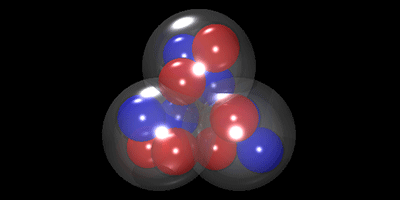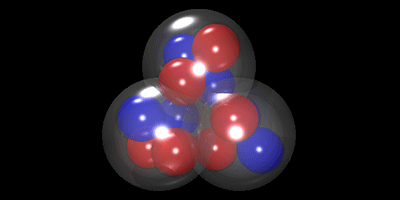Carbon-12 Caught in a Triangle
Carbon-12 ( ), like many nuclei, doesn’t conform to the simple picture of the nucleus as a homogenous distribution of protons and neutrons. Instead, its nucleons are thought to cluster into alpha particles (two protons and two neutrons) that arrange into an equilateral triangle, a configuration with symmetry. Several observed nuclear excitations support this picture. Now, Daniel Jose Marin-Labarri at the University of Birmingham, UK, and his colleagues report in Physical Review Letters the measurement of a new state that provides additional evidence for the triangular cluster model of . The finding could point physicists to more accurate models of carbon’s structure, which are needed to better understand carbon nucleosynthesis.
Working at the Birmingham cyclotron facility, the researchers used a beam of high-energy helium- to excite and break apart the nuclei in a carbon target. By measuring the momenta of the emitted alpha particles they were able to reconstruct the energy levels of the carbon nuclei. Models of that assume it has symmetry predict a band of rotational states (think of a spinning top) having spin and parity, and ; Marin-Lambarri and his colleagues observed the last of these, , at an energy of mega-electron-volts.
The measurement could lead to a better understanding of the Hoyle state—an excited state of carbon-12, essential for nucleosynthesis. If, as Marin-Labarri’s data suggest, the cluster model is the right one, the Hoyle state is due to a breathing mode excitation of the triangular configuration. But this contradicts the findings of ab initio calculations (see 9 May 2011 Viewpoint), which suggest that the spatial structure of the Hoyle state is more like a linear chain of three alpha clusters. Future measurements of other states predicted by the two differing models are needed to decide which one best describes carbon. – Kevin Dusling





